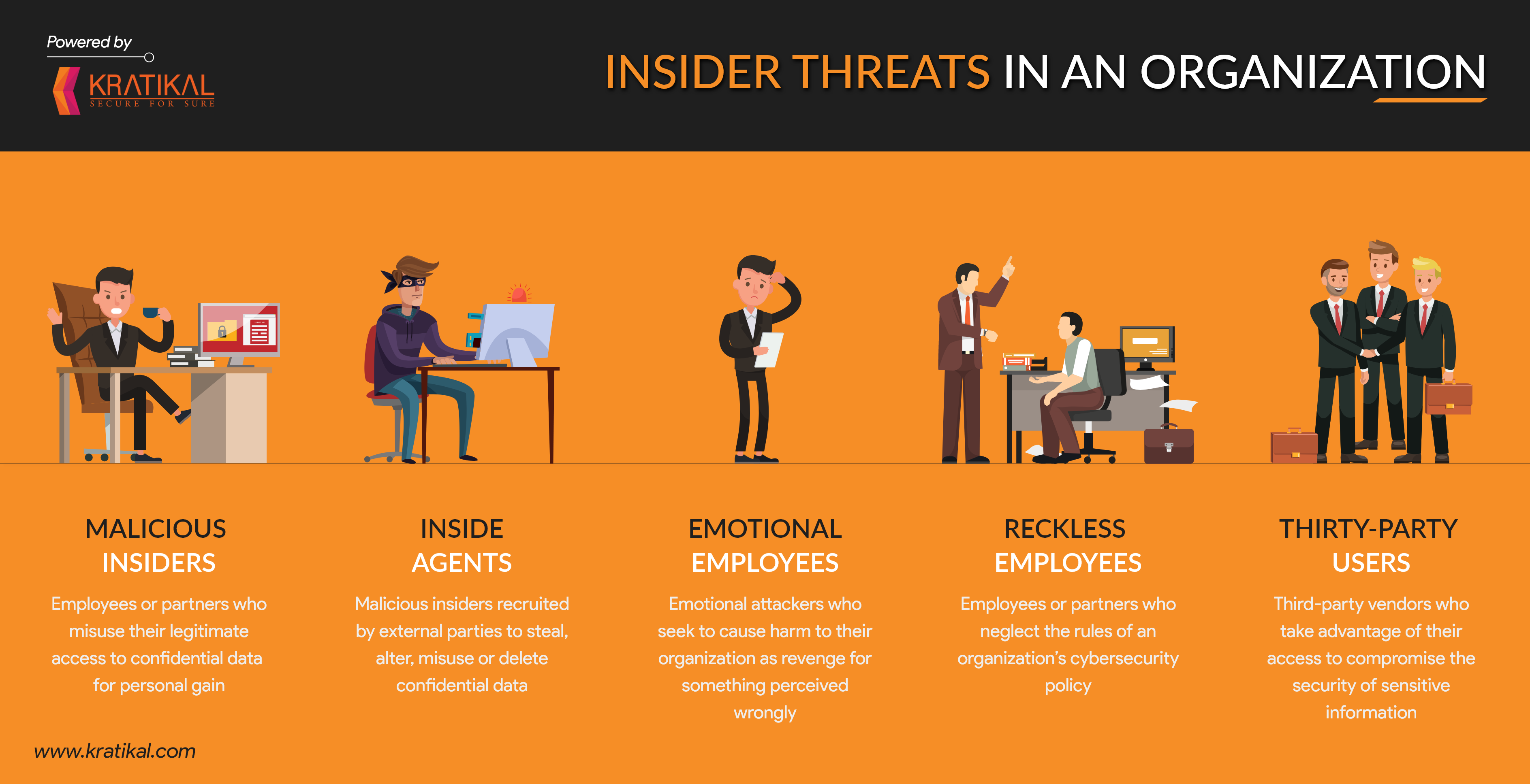Have you ever wondered why so many companies go through sudden data breaches? Insider threats often play a major role in these scenarios!
For example, in 2017, an employee from Bupa company got access to sensitive customer information through the customer relationship management system. The ‘insider’ copied all the user databases and then deleted them from the system. The employee then attempted to sell that data on the Dark Web, leading to the compromise of data belonging to 547,000 customers.
Table of Contents
ToggleWith increasing competitiveness and ongoing enterprise development, it has become a common occurrence where some employees and ex-employees to attempt to sell information about an organization. According to an article by HelpNet Security, about one in every three organizations has reported being a victim of insider threat. It is becoming a rising concern for various organizations because the problem is quite dynamic and complex. This kind of risk affects both the public and the provider domain.
Subscribe to Our Newsletter On Linkedin
Sign up to Stay Tuned with the Latest Cyber Security News and Updates
What is an Insider Threat?
Cybersecurity and Infrastructure Security Agency (CISA) defines ‘Insider Threat’ as:
“Any individual that can be considered an ‘insider’, who belongs to a company and uses their accessibility to exploit the organization’s information, whether intentionally or unintentionally, eventually harming the organization’s resources, facilities, personnel or system. These activities could sometimes lead to terrorism, espionage, sabotage, information disclosure, corruption, etc.”
An insider threat is a risk of losing your organization’s sensitive and important information because of the menace within the company. The notion of ‘within the company’ is what gives this risk its name – “Insider Threat”.
The danger posed by insider threats lies in the fact that this individual, who poses a risk to the organization, possibly has access to the organization’s intelligence. The biggest advantage of insider attacks is that it does not require much technical or cyber expertise and with better connections and lucrative offers, one could exploit an organization’s sensitive data.
Book a Free Demo Call with Our People Security Expert
Enter your details
An insider threat is someone who has authorized access to your organization’s critical systems or the information and poses a security risk to the organization by misusing the authorized access.
The insider threat doesn’t have to be a current working individual or stakeholder of your organization. It can be either a former employee or board member who still possesses access to your organization’s proprietary or sensitive information. In most cases of insider threats, emerging companies get privileged and unauthorized information about another company or enterprise through their existing or ex-employees.
What are the Types of Insider Threats?

There are two types of Insider Threats. They are – Malicious and Accidental. The ‘insider’, who is often responsible for such occurrences is either a malicious individual, a mole, or a novice insider.
Malicious Insider Threat:- These are carried out intentionally by any individual who is an insider. These people willingly share the information of the company which is usually PII (Personally Identifiable Information), IP (Intellectual Property), or any kind of financial and strategic information.
Accidental Threat – These kinds of risks and vulnerabilities occur due to any employee who has been unintentionally negligent with the information of the organization or their credentials. Human error is the root cause of accidental insider threats.
Insider threats are hidden in every vertical today and can be catastrophic to businesses if ignored. The CISOs and CIOs of organizations must implement insider threat training for employees. Every IT security official should consider insider threat protection as the ‘need of the hour’ in this current situation of remote work culture.
How to Identify Insider Threats?

The indicators of insider threats can be categorized into two parts- behavioral and digital. The behavioral indicators are attempting security bypass, presence in the office during off-hours, aggrieved behavior, violation of corporate policies, looking for new opportunities, and acting strange. The digital indicators are procuring large amounts of data, data sharing, saving and seeking sensitive data, access requests for data that is not associated with designated job roles, and using unauthorized devices for storage.
How Insider Threats Pose Risks to Your Organization?
A lot of information about an organization is accessible to every employee. In many cases of insider attacks, companies suffered the compromise of highly sensitive data including intellectual property, confidential records, and trade secrets. Organizations often tend to overlook the ‘insider threat’ but they are the biggest contributors to cyber attacks today.
Various statistics reveal that insider threats can be from employees, contractors, trusted business associates, or anyone that has easy access to your organization’s network. During the global lockdown due to the COVID-19 pandemic, many employees were furloughed or laid off which has caused widespread stress. In these circumstances, the reduced number of employees in the IT team has also put organizations at risk.
Insider threats can incur a huge amount of financial loss to the company. The direct impact is on data and companies’ policies which get compromised. This also hampers and impacts the integrity of the organization.
Why are Insider Threats More Dangerous Than Other Risks?
The advantage of insider threats over the other types of risk is that fundamental data can be easily accessed. In many cases, the malicious employees have handed over basic information about the organization such as ongoing strategies, company goals, policies, weekly or monthly targets, etc.
Insider threats can be difficult to recognize and even more difficult is stopping them from causing harm to the organization. However, by implementing and working on preventive measures, an organization can stay secure. Along with the right security solutions and tools, educating employees about the importance of data security is very important. They should be trained to follow security policies and procedures to mitigate prevailing insider threats.
How to Decrease Insider Threats?
There are certain sets of practices that are followed diligently to prevent and reduce risks and vulnerabilities associated with insider threats. Some of these practices are listed below –
- The company can employ enterprise-wide risk assessment to comprehend whether an employee is carrying out suspicious activities.
- The majority of the cases of insider threats are unintentional, in which sensitive and private information is exposed accidentally. Organizations can also use an influential tool like TSAT, which can be used effectively to educate employees, and preventing human error and negligent behavior.
- The company can employ strict practices for account management and credentials control.
- Every employee must be monitored regularly on multiple fronts and the network perimeter should also be monitored.
- Educate employees with a security awareness training tool that offers simulated cyber attacks for real-life experience training.
- Identify and report suspicious activities or behaviors indicating an employee to be a probable insider threat.
- Keep data secured by granting limited access permission to confidential information.
- Regularly update and maintain the user access privileges list.
- Establish a strong password policy to keep the passwords safe.
- Patch all vulnerabilities with the latest updates from time to time to prevent cyber threats like SQL injection attacks, DDoS attacks, etc.
Summing Up
Insider threats have become a major concern for organizations worldwide, especially since lockdown when work from home became prevalent and employees couldn’t be completely monitored. The employees are the most vulnerable entity in the organization. To prevent accidental and human error, the companies must employ security awareness training tools like TSAT to protect the organization.
What preventive measures should organizations follow to reduce insider threats? Comment down below your views to let us know!
